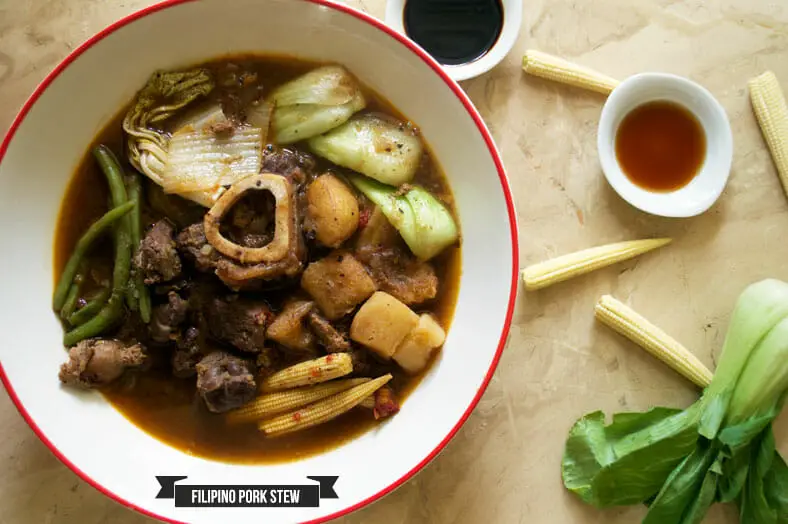Sometimes it simply doesn’t do a dish justice to try drawing parallels for it.
Sure, pochero is kind of sort of “like Spanish cocido,” except that it’s simply not.
While conceptually the same thing, the Filipino version of pochero has evolved into something far more exquisite than that.

Pochero, Spanish Influences, and Unique Filipino Tastes
In order to even begin understanding the local flairs applied to Filipino pochero, we need to take a dive into the idiosyncrasies of an undeniably unique, truly special broader Filipino cuisine.
A Cuisine Shaped by Outsiders
Sure, pochero itself comes to us by way of the Spaniards and other Spanish colonies, but core tenets of the Filipino cuisine – those that play a pivotal part in today’s version of this beef stew – go much further back than that.
Though there’s an ongoing debate as to whether the Filipino people might evolved locally – at least according to anthropologist Wilhelm Solheim’s Theory of Island Origin – an unquestionable turning point in the archipelago’s modern history kicked off around 4000 BC.
At this point, a Sino-Tibetan culture of skilled fishermen began an extensive series of colonizations by sea, a particular period now commonly referred to as the Austronesian Expansion. The Austronesian Expansion had two profound effects on the islands. First, it laid the ethnographic foundation upon which future influencing cultures would build. Second, it connected the people of the archipelago to the peoples of the mainland.
Until the rise of the Kingdom of Tondo in the year ~900, there’s unfortunately not too much recorded history by which to understand the way of life following the Expansion. Still, there are off and on recounts from other civilizations like the Malays that mention trading with seafaring peoples arriving in balangays, or hollowed out wooden plank boats historically common in Philippine trade.
It was during the time of the Kingdom of Tondo, however, that the different island powers formalized, banded and began to seriously engage in major commercial activities with outside Empires. The Kingdom itself is technically a thalassocracy, or an “Empire at sea” that united islands sharing maritime routes towards a common commercial and political interest. Between the 9th century and the arrival of the Spanish in the 15th, the Kingdom of Tondo held strong diplomatic and commercial ties with China (particularly the Ming Dynasty), Japan, the Malay Peninsula and India.
Eventually, it was its effective monopoly on trade with China that did the Kingdom in. In the late 15th century, the Bruneian Empire launched a successful attack on Tondo in order to break up this monopoly. What resulted was the creation of a Bruneian satellite state Selurong, where modern day Manila now is. The fall of the Tondo thalassocracy broke shaky truces and led to a period of infighting between the various semi-autonomous island kingdoms.
And it was this infighting that made the colonization efforts for the Spaniards much, much easier.
Arrival of the Spaniards
Though he was most likely not the first European to make it to the archipelago, the beginning of the Spanish colonization efforts are thought to have begun with Ferdinand Magellan and his voyage in 1521. On this trip, Magellan landed on the shores of Homonhon, an island on the Eastern side of the archipelago. Magellan then claimed a few islands for Spanish sovereignty, which he named Las Islas de San Lazaro, before continuing to explore the multitude of other islands around.
Magellan would be killed in a battle on the island of Mactan, but the Spanish influence had only just begun. Over the next several decades – and particularly under the leadership of Miguel Lopez de Legazpi – the Spanish commissioned expeditions to form settlements and annex the islands as part of the greater Empire. By 1571, the Spanish had captured Manila and began consolidating Las Islas Filipinas (in honor of Spanish King Philip II) under the Spanish Empire.
Over the next 2 centuries, the Spanish would continue its systematic colonization – and corresponding mass conversion of the local people to Roman Catholicism – of the remaining fragmented islands. By the end of Spanish rule in the late 19th century, the islands had again been politically unified (in a stronger way) for the first time since the Kingdom of Tondo.
Effects on Filipino Cuisine
The Philippines’ uniquely checkered past has led to a cuisine that is quite unlike any other you’ll find in the world. After all, how many can boast strong Malay, Chinese, Latino and American influences on top of an already extensive local cuisine.
Let’s start with what’s indigenous to the islands. Because of its tropical climate (and the fact that there are 7,100+ islands in its sovereignty), the Filipino cuisine boasts an array of delicious, nutritious and special fruits and vegetables. Ingredients like saba bananas, kalamansi, kangkong (a type of spinach), mangoes, talong (eggplants) and more make their way into both sweet and savory dishes alike.
While not necessarily prevalent in pochero itself, another ingredient that Filipino cuisine makes abundant use of is vinegar. Originally, it was one of the few ways to keep food from spoiling in the islands’ hot and humid tropical climate, but now it is as much for the preferred tart flavor as it is for its utility.
Some of the greatest influences come from the Chinese and Malays. Where the Malays left a footprint primarily in cooking methods and the heavy use of all things coconut, the Chinese left their mark via noodle-based dishes like pancit, perhaps the most famous of a multitude of Filipino dishes. There are also other Chinese-inspired dishes like pancit molo (a wonton soup), goto (a congee), and siopao (steamed buns) that are still very much prevalent today.
Then there’s the Spanish. In addition to pochero (which we’ll discuss in a bit), the Spanish introduced various types of ingredients and dishes that have become staple Filipino dishes into today. For example, you’ll find dishes like pochero, paella, arroz a la valenciana and all sorts of jamon and chorizo used plentifully in other dishes.
About the Recipe
Before diving into the recipe, we feel it’s important to mention that technically there are various types of pochero made all over the world. There’s pochero/puchero dishes in Mexico, Argentina, Colombia, Paraguay, Uruguay and of course the main “land of inspiration”… Spain.
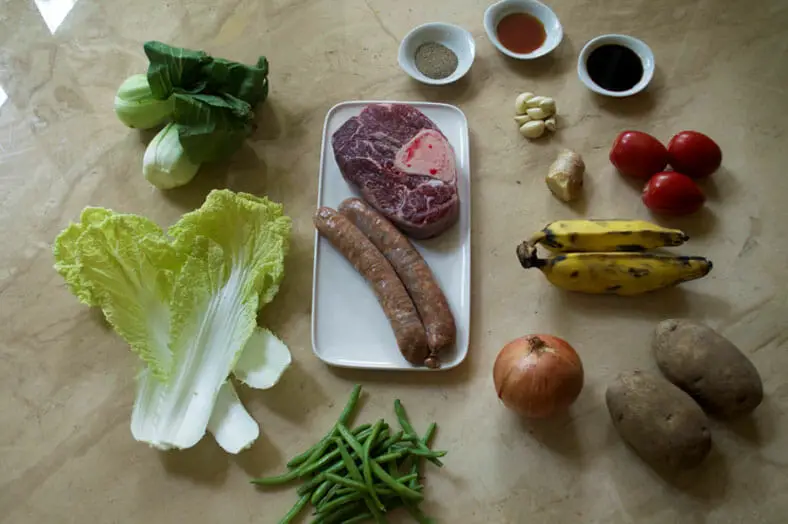
The translation of the word itself will give you a sense as to what to expect from it. The Spanish word of puchero translates into English as either “pot” or “stewpot,” which is what the Filipino pochero is all about.

To start, you’ll want to pre-cook most of the “heftier” ingredients that will eventually get stewed. For the most part, this means browning and frying your starchy vegetables before setting aside to pre-sear your meat. In our particular case, we just happened to pre-cook our chorizo and use the residual oils and fats to brown/sear the remaining ingredients in it.


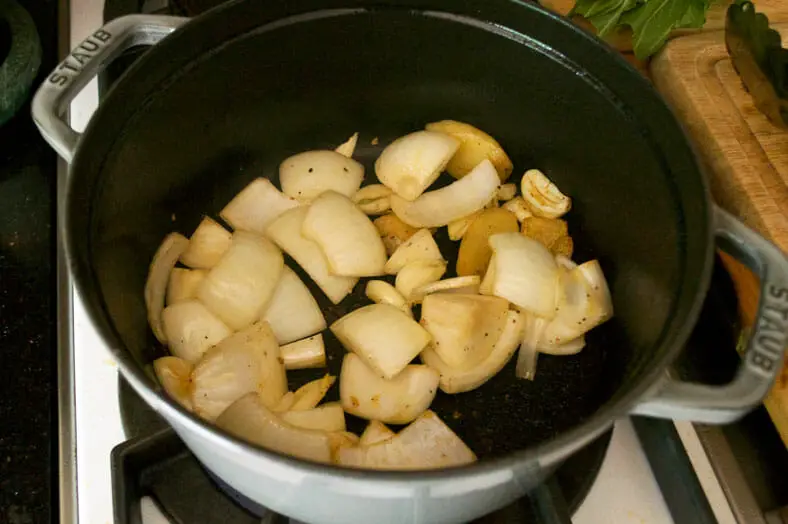
Once your starchy vegetables have been browned, you’ll start by searing your chunks of meat in your piping hot stewpot (or Dutch oven (on Amazon)) in order to get it nice and brown as well. Adding in onions and garlic at this point is a nice added touch to give some aromatic flavor to your meat as it sears.
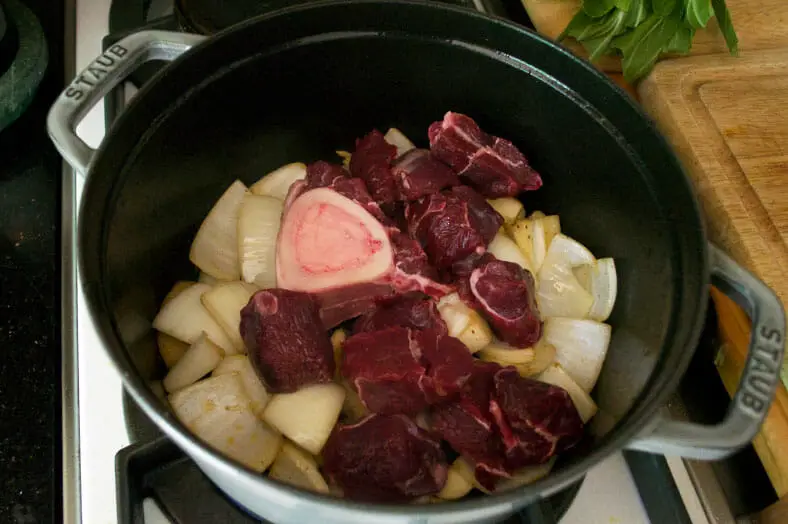
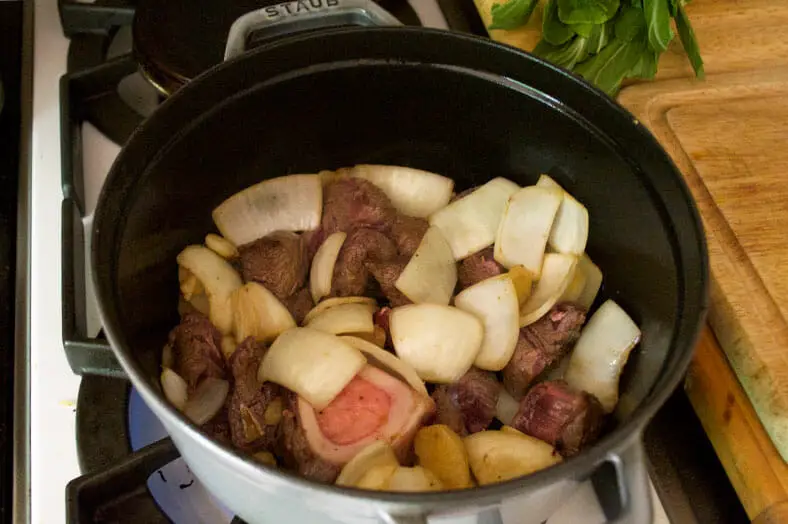

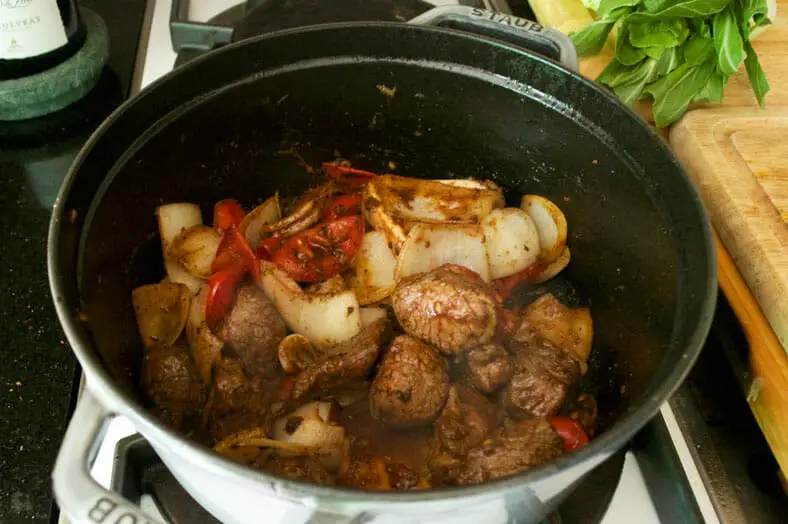
As your meat starts to brown, you’ll want to build up the broth around it. Pochero most commonly calls for a tomato-based broth, which you can make either with ketchup or tomato sauce or a combination of the two.
It’s here in the building of this sauce that you’ll see some typical Filipino flairs to the dish. More generally, a lot of Filipino cooking will work to balance elements of tamis (sweet), alat (salty) and sour (asim) into a bold-flavored resulting dish. In the case of pochero, this gets achieved with a mixture of sugar, soy sauce, and sometimes patis (fish sauce (on Amazon)) added into the broth.
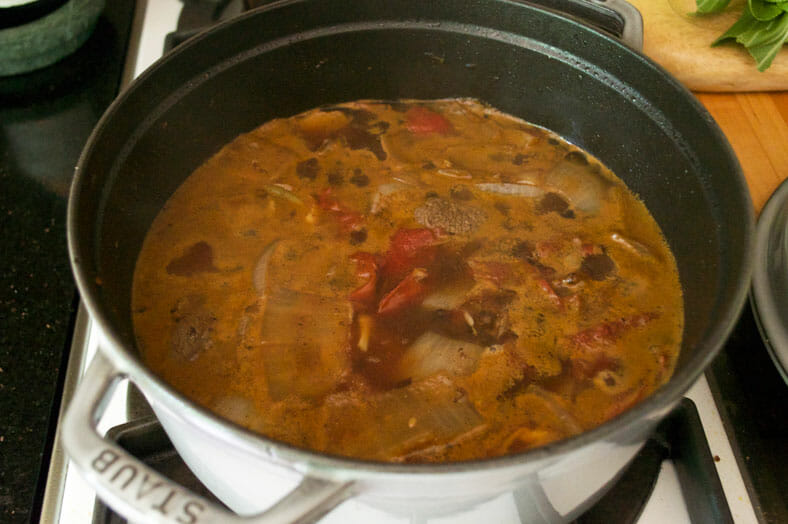
Add enough broth and/or water to submerge your meat and round out your broth, then you’ll bring everything to a quick boil. Lower the heat and let everything simmer together on a low heat.
Over the course of your simmer, you’ll want to slowly introduce more and more of your other pochero ingredients into the stewpot. Earlier on, you’ll want to add back in your starchier ingredients like potatoes and saba bananas (more on this one in a bit). Then, as it gets closer to serving time, you might want to add in ingredients like Napa cabbage, baby corn, carrots or anything else.
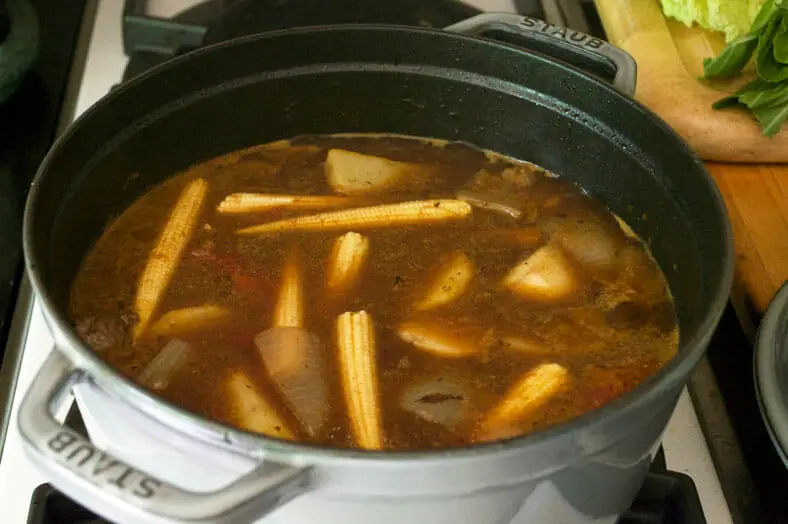
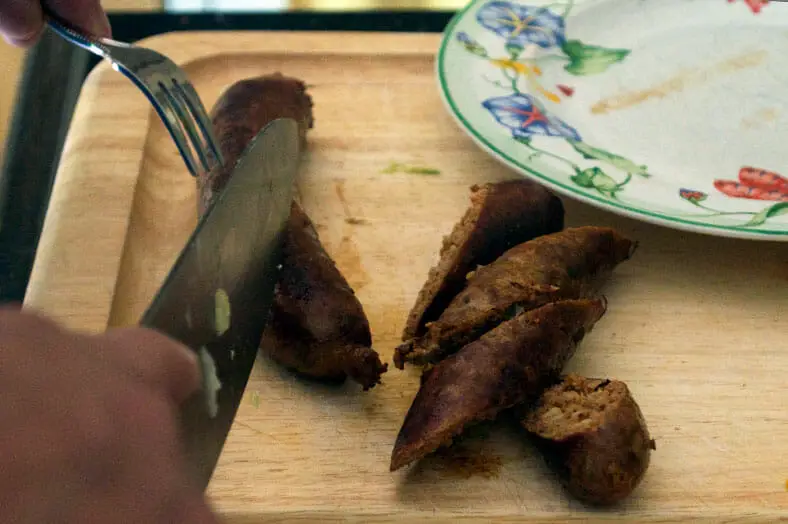
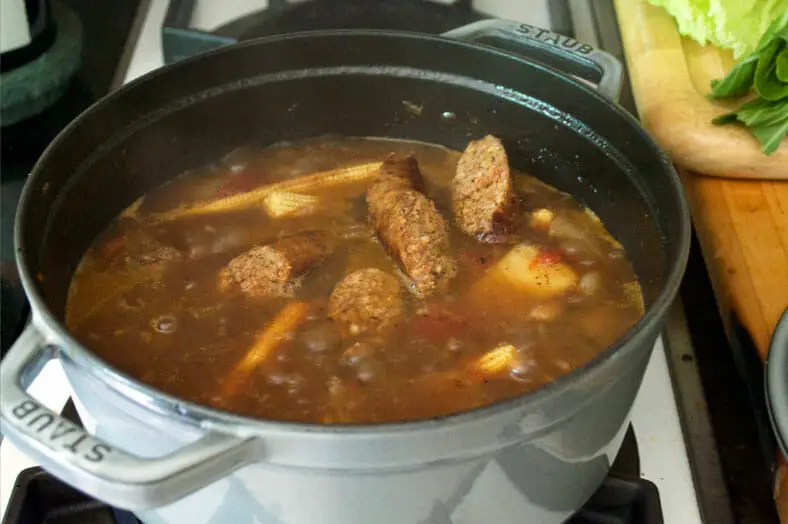
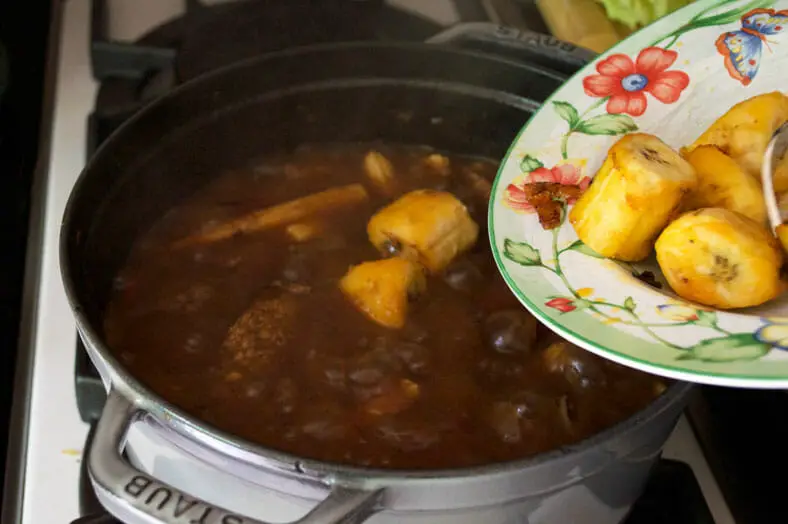
After at least 45 minutes of simmering everything together, your pochero is ready to go. The tomato-based broth will now have a delectable and robust flavor to it, and the soft meat complements the hearty starchy vegetables beautifully.
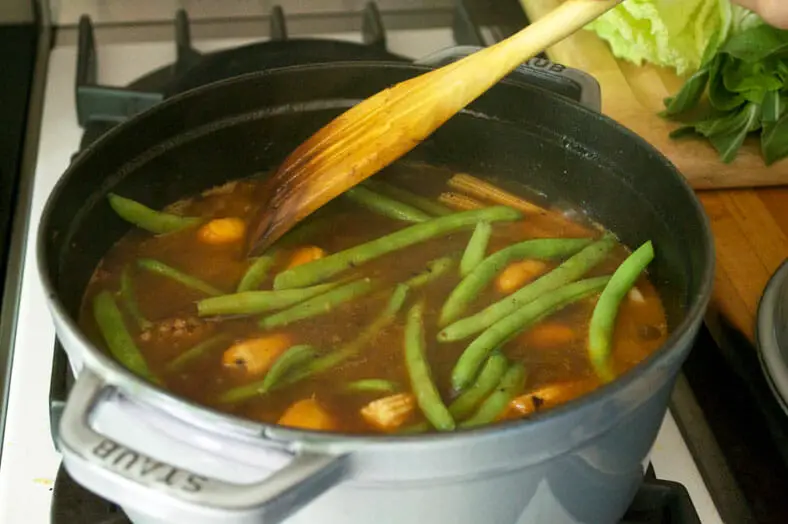

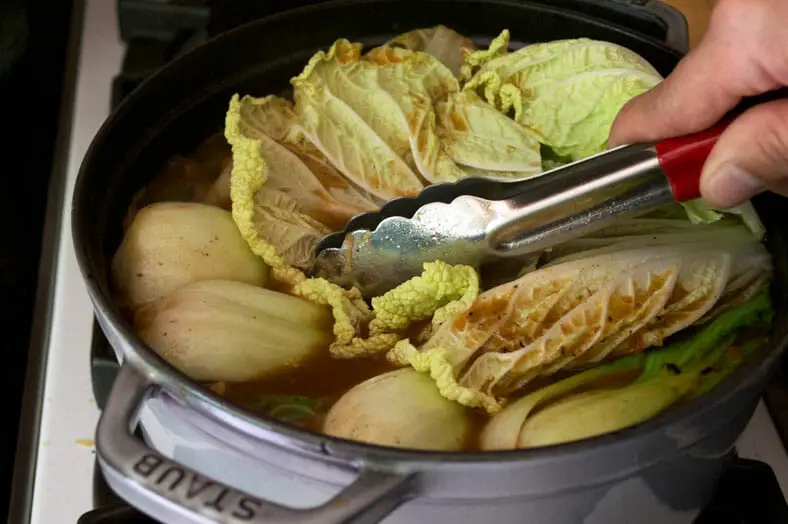
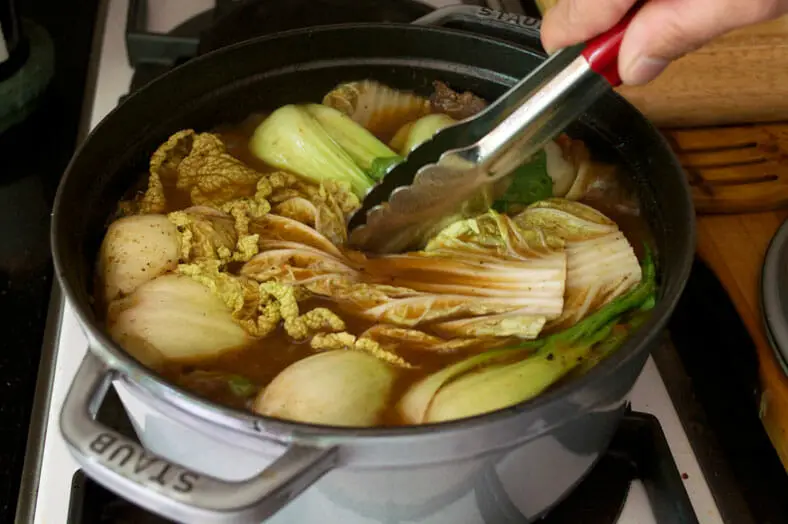
Saba Bananas
This is just more a quick word than anything else about this truly special ingredient.
Unlike most other bananas – especially the ones we associate as sweet and easily mushed – the saba banana offers an interestingly lighter flavor to perhaps otherwise intense Filipino dishes when cooked.
In some ways, it’s more like a potato than it is a banana in that it has a similar nutritional makeup and is cooked more often like the root vegetable.
Our Take on the Recipe
This was a really exciting recipe to make for two reasons. First, someone very dear to us is from the Philippines and is an absolutely fantastic cook, so we stepped completely aside and let her work her magic. It was an amazing experience.
Also, it was an opportunity to showcase a recipe from one of our favorite bloggers out there, Manila Spoon. Her pochero recipe – which we used as our original reference – comes out amazing no matter what ingredients or what meats you decide to put in there.
For ours, we opted to go the route of making our pochero with beef (flank) along with a little bit of chorizo for extra spice and flair. As you’ll see in our recipe, one procedural change we made was to pre-sear the chorizo first, after which point we seared our potato and saba banana in the residual goldenrod oils.
We cut out the tomato sauce and ketchup altogether, opting to make a broth from fresh tomatoes and homemade vegetable broth instead. Per the recommendation of our dear friend, we actually cut out most of the patis as well in the final version, instead letting soy sauce do most of seasoning.
In terms of vegetables, we added baby corn, napa cabbage and green beans into the recipe, both of which came out fantastic in the final dish. We also swapped out russet potatoes in place of the red potatoes suggested.
All in all, pochero might have been one of our absolute favorite dishes to make so far on this Arousing Appetites journey, and it’s one that we’d highly recommend to you as well… especially if you have tons of leftover vegetables in the fridge.
Enjoy!
How would you make your pochero? Comment below!
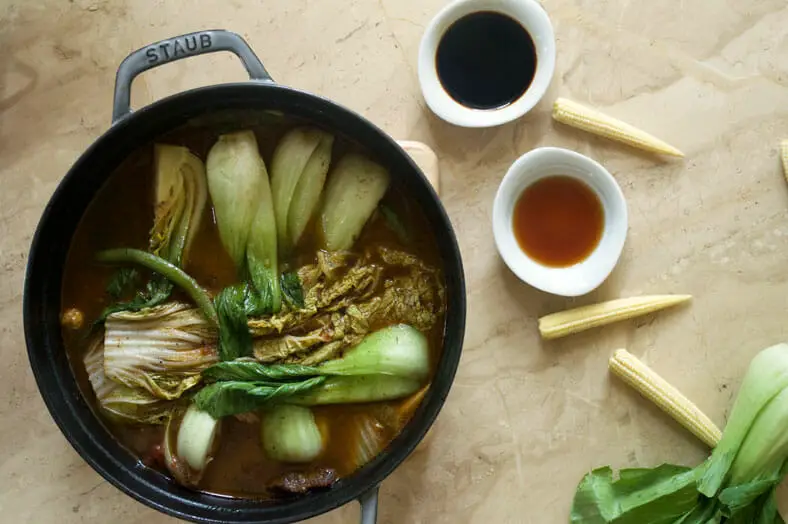

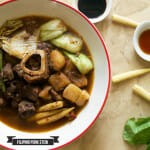
Pochero: Phillippine Pork Stew
- Total Time: 1 hour 30 minutes
- Yield: 6 people 1x
Description
Pochero: Phillippine Pork Stew with medium-sized tomatoes, cut into large chunks.
Ingredients
- 1 pound beef (preferably bone-in, preferably shank), cubed
- 2 chorizo sausages
- 3 medium sized tomatoes, cut into large chunks
- 1 medium-sized yellow onion, cut into large chunks
- 1 1-inch knob of ginger, sliced into thick pieces
- 6 garlic cloves, pounded but not minced
- 4 cups water or broth
- 1 handful baby corn (optional)
- 2 Russet potatoes, cubed
- 1/2 cup green beans, cut into large pieces
- 4 bunches bok choy, halved or quartered
- 2 leaves Napa cabbage, cut into large pieces
- 2 teaspoons soy sauce
- 1 teaspoon patis, or fish sauce (on Amazon)
- 1 teaspoon black pepper
- 2–3 tablespoons coconut oil
- 2 ripe saba or burro bananas (optional)
Instructions
Stage 1 – Pre-Fry Your Chorizo
- Start by placing a Dutch oven (on Amazon) over medium-high heat. Once hot, add your chorizo without any oil and sear for ~5 minutes. If you’d like or if you think it is becoming too dry, add splashes of water occasionally
- After 5 minutes, remove your chorizo from the Dutch oven (on Amazon) and set aside
Stage 2 – Pre-Cook Other Ingredients
- Pre-cooking the chorizo (along with a splash of water) leaves a flavorful oil in which to cook the rest of the ingredients
- If cooking with burro bananas, add the bananas first and cook them in the oil. They should develop a nice red hue to them after 3-4 minutes, at which point you can take them out and set aside as they start to lightly brown
- Next, add your potatoes into the oven and do the same thing. Saute for 5 minutes, occasionally flipping on each side so as to create an even brown. Once browned, take out of the pot and set aside
Stage 3 – Create the Basis for Pochero
- Add your ginger chunks and pounded garlic to the Dutch oven as a means of “deglazing” what has stuck to the pan. Use a ladle to move around for about 1 minute as the garlic and ginger become fragrant
- Throw your chunks of onion and saute for another 1 minute before adding the meat
- As the onions start to sweat and become fragrant as well, add your meat in order to sear. You want as much of the meat’s surface area to touch the bottom of the pan so as to help it brown. Sear for at least 3-4 minutes so that all sides of the meat get nice and evenly brown
- As the meat starts to brown, add your tomatoes in with the same tactic. Move all ingredients to one side or another in order to let your tomatoes directly touch the bottom of your pot. Sear the tomatoes for at least 3-4 minutes as they start to soften
- Once your tomatoes have seared, add your black pepper and 1 teaspoon of soy sauce then mix thoroughly
- Add your water or broth and cover your pot. Let the liquid come to a boil
- Once the liquid has begun boiling, add your next teaspoon of soy sauce and salt. Re-cover the pot and reduce the heat to a simmer. You’re going to let everything in the pot simmer for 20 minutes
Stage 4 – Finishing the Pochero
- After 20 minutes, check in on your pochero and see how it’s going. By now, the meat should be halfway to the desired level of softness, and it’s a good time to introduce your remaining ingredients
- Add your potatoes and baby corn and mix into the dish. Re-cover your pot and bring it again to a boil. Once boiling, reduce again to a simmer for another 15 minutes
- During this 15 minutes of simmering, take your chorizo and cut it into smaller slices. At the 15 minute mark, you’re going to add your chorizo and simmer for another 5 minutes
- Next, add your Napa cabbage, burro bananas, bok choy and green beans. Gently push the cabbage down to the bottom of the pot to submerge it under the juices. Re-cover the pot and continue to simmer for 3-5 minutes before turning off the heat
- Let your pochero sit covered for another 5 minutes as it cooks in its residual heat, and you’re done!
- Prep Time: 15 mins
- Cook Time: 1 hour, 15 mins
- Category: Dinner
- Cuisine: Filipino
